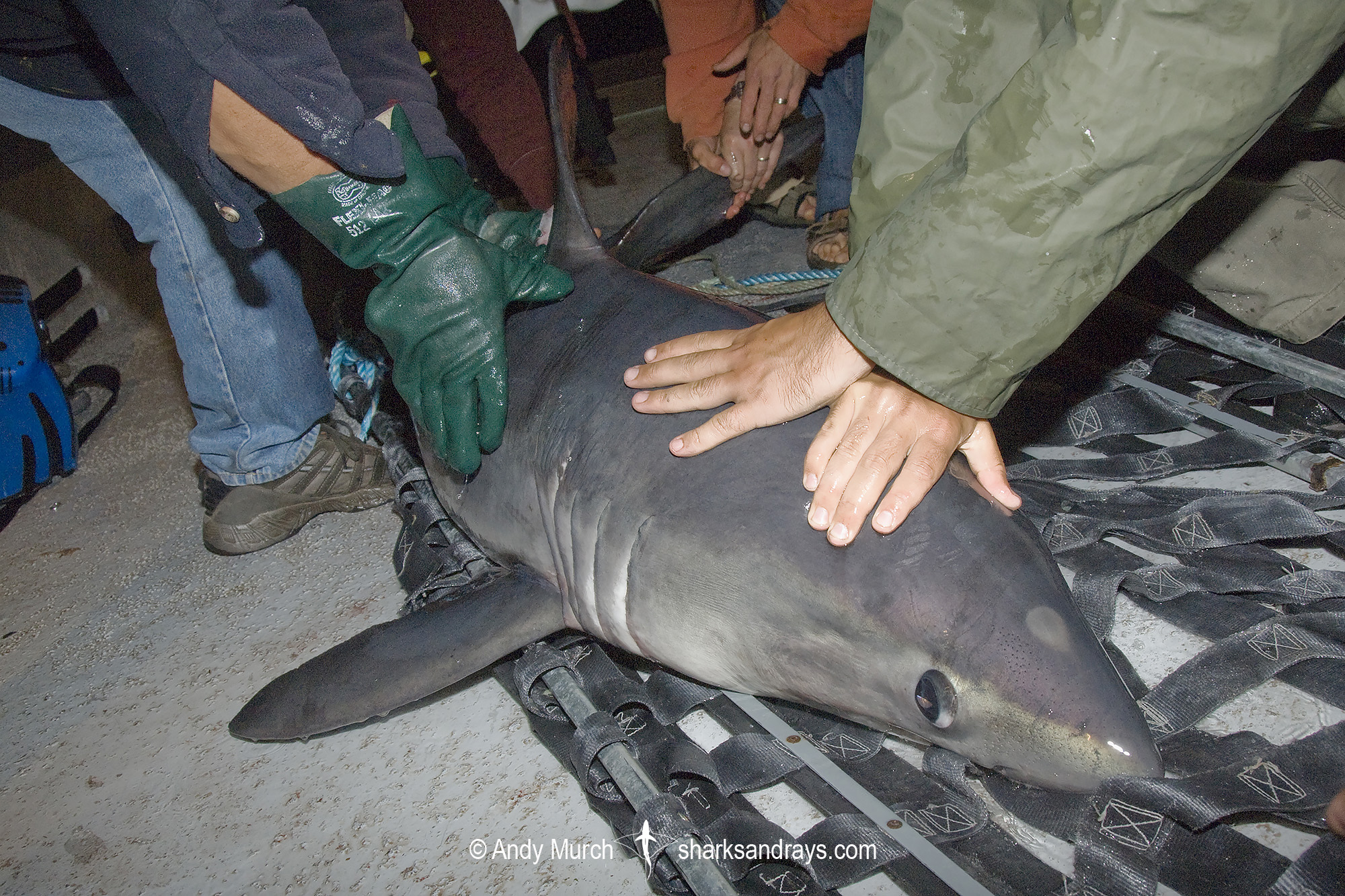Common name(s)
Blacknose Shark.
Identification
Small but stocky. Black/dark spot on tip of snout; distinct in young animals but often an indistinct smudge or absent in large adults. Pectoral fins relatively small. First dorsal origin level with free rear tip of pectoral fin. Second dorsal origin level with anal fin origin. No interdorsal ridge. Dorsal coloration pale yellowish-grey or light olive-grey. Body looks more bronzy in bright sunlight. Second dorsal, anal fin, and lower caudal lobe often dusky. Ventral surface white or cream coloured.
Size
Maximum length 141cm (Jose Castro). Size at maturity approx 100cm. Size at birth 31-50cm.
Habitat
A warm water species inhabiting coral reefs and sand flats/scrub.
0-64m. Often cited as occurring between 18-64m, but in the Bahamas I have consistently encountered blacknose sharks in shallow water (surface to 10m) where they are abundant.
Distribution
The blacknose shark is a tropical coastal species from the western Atlantic, Gulf of Mexico, and Caribbean Sea. It has been recorded from Virginia to Southern Brazil but rarely strays north of Wreck Island in North Carolina.
Conservation Status
NEAR THREATENED
The blacknose shark is fished in large numbers in parts of its range. It is caught in both the large and small coastal directed shark fisheries along the US Atlantic coast and is probably a target and bycatch in coastal fisheries throughout the rest of its range. It suffers considerable mortality as bycatch in US shrimp trawl fisheries causing the stock to be currently overfished. Shrimp trawl fisheries are intense in inshore waters throughout the Gulf of Mexico and on the Caribbean coast of South America. No information is available on catches or population trends for Blacknose Shark in this area, but it is possible that it is also declining there. However, analyses of data from northern and northeastern Brazil indicate that there is no evidence of population decline there, and large, mature adults are still present in catches. While the US population has declined, most of the decline has occurred since 2000 (less than one generation) and management actions will be required to rebuild the stock. This species is assessed as Near Threatened globally, reflecting continuing declines observed in the US Atlantic and apparently stable populations off northern Brazil. No species-specific data or information is currently available from the Caribbean Sea, and assessment of catches and population trends in this area is a priority. With further information from this region, the species may qualify for a threatened category (VU A2bd+A4bd). Population trends should continue to be monitored and efforts should be made to collect data throughout the rest of the species’ South American range.
Citations and References
Morgan, M., Carlson, J., Kyne, P.M. & Lessa, R. 2009. Carcharhinus acronotus. The IUCN Red List of Threatened Species 2009: e.T161378A5410167. https://dx.doi.org/10.2305/IUCN.UK.2009-2.RLTS.T161378A5410167.en. Downloaded on 22 September 2020.
Reproductive cycle of the blacknose shark Carcharhinus acronotus in the Gulf of Mexico
J. A. Sulikowski, W. B. Driggers III, T. S. Ford, R. K. Boonstra, J. K. Carlson
First published: 02 February 2007
Reproduction
A viviparous species with yolk-sac placenta. 1-8 pups per litter.
In South Carolina, mating takes place in early to mid June (Driggers 2002). Gestation in S. Carolina is 10-11 months. 9-10 months in the Gulf of Mexico (Sulikowski et al. 2007).
Diet
Diet consists mainly of small bony fishes.
Behavior
Blacknose sharks undergo seasonal migrations related to water temperature. They are know to perform agonistic displays (fins down, back hunched) when threatened.
Reaction to divers
Shy around scuba divers but surprisingly bold in baited situations.
Diving logistics
Near South Bimini Island in The Bahamas, blacknose sharks are often encountered during Caribbean reef shark feeds at Triangle Rocks and Southern stingray feeds at Gun Cay. The depth at both sites is less than 6m. These dives are only offered by land-based operators because most liveaboards are too large to approach those dive sites.
Andros Island is reputedly another good place in The Bahamas to find blacknose sharks; moving in and out of the mangroves with the tide. However, I did not encounter any when I was there.
Further south in the Caribbean in Sint Maarten, the reef shark feed organised by Dive Safaris (local operator) used to attract a handful of blacknose sharks but they became less frequent over time. It is unclear if they were fished out or if competition with the attending Caribbean Reef Sharks became too great.
What’s new
View our full list of updates
Similar species
The blacknose shark’s small, stocky shape and black nose make misidentification in the field unlikely.








